This fermented honey garlic is the perfect thing to make to boost your immune system! Both honey and garlic have strong medicinal benefits, so you’ll want to have this delicious home remedy on hand for cold and flu season.
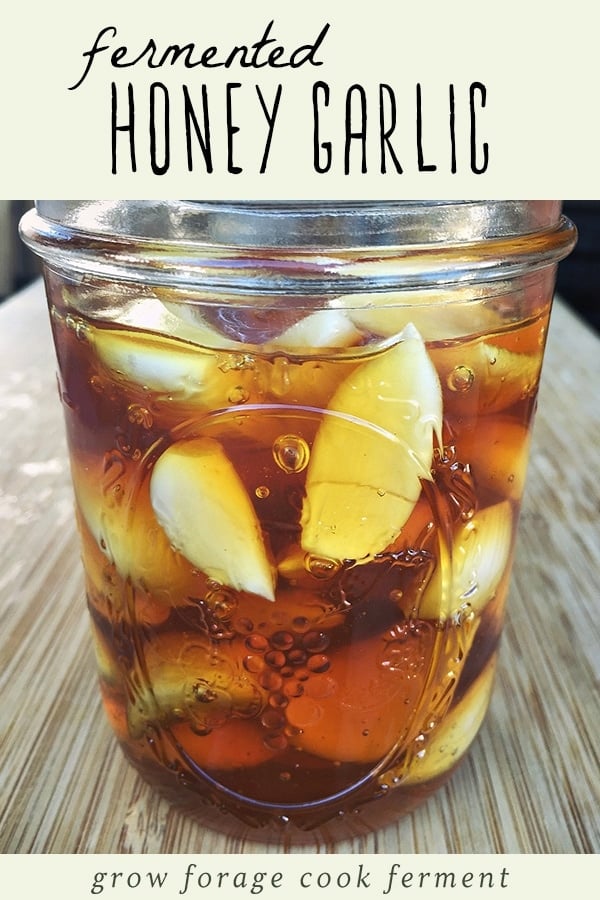
Want to save this post for later?
Fermenting Garlic in Honey
I’m really excited to share this post with you! Fermented honey garlic is something I’ve been wanting to try for a very long time, ever since I first read about it on the Killer Pickles blog.
I usually reserve my honey for mead making, but using it for other ferments intrigued me. Don’t ask me why I haven’t done it until now, because it’s the easiest thing in the world!
This tasty fermented garlic in honey can be used for many things, as good food and good medicine. Honestly though, I like to just eat it as is!
Fermented Honey Garlic Recipe
Making fermented honey garlic is so easy, it hardly needs a recipe!
Prepare the Garlic
The hardest and most time consuming part is prepping all of the garlic. Whatever size jar you use, you’ll want to fill it about 1/2-3/4 full of peeled garlic.
The quickest and easiest way to prep garlic is to place the side of a chef’s knife on top of a single clove and then give it a firm whack with the palm of your hand.
Don’t do it too hard, as you don’t want to crush the garlic, but just enough to lightly bruise the it. This will make it easy to peel, and will also release a bit of the garlic juice.
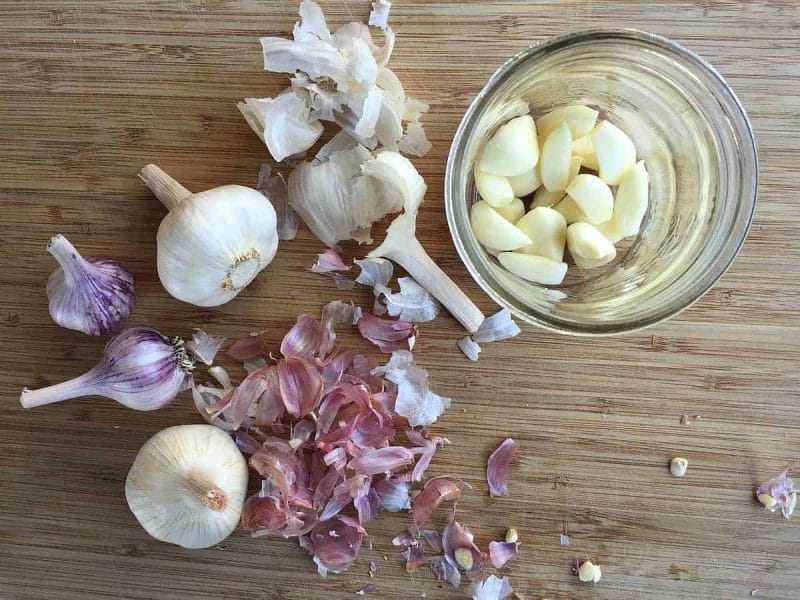
Add the Honey
Once you have enough garlic in your jar, pour in some raw honey to cover it. The garlic will probably float a bit and that’s ok.
It’s important to use raw honey to make fermented garlic in honey, as it will still have all the bacteria and wild yeast that is necessary for fermentation.
When liquid is added to honey, it jump starts the fermentation process. The small amount of juice from the garlic will create just enough liquid for fermentation to happen.
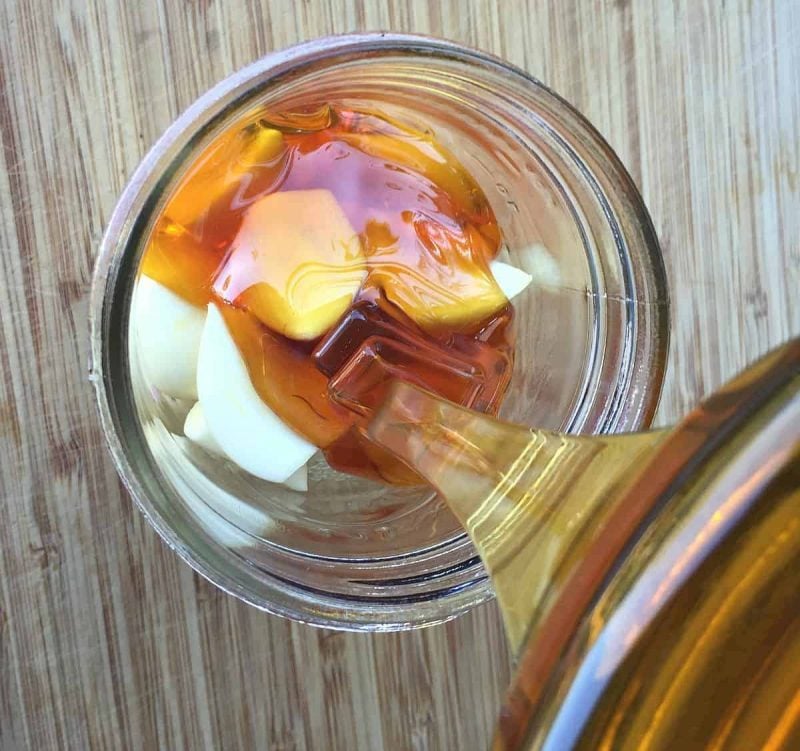
Cover and Flip
Cover the jar loosely with a lid to let the gasses escape, and put it in a dark place to ferment.
It’s a good idea to put a plate or something similar underneath the jar as it’s fermenting, as it will likely bubble up a bit and a little honey could possibly drip out.
It’s also important to gently turn the jar over every day or so, or whenever you think about it, to make sure that all of the garlic stay coated with honey.
Screw the lid on tightly before you do this! Then return it to it’s upright position and re-loosen the lid.
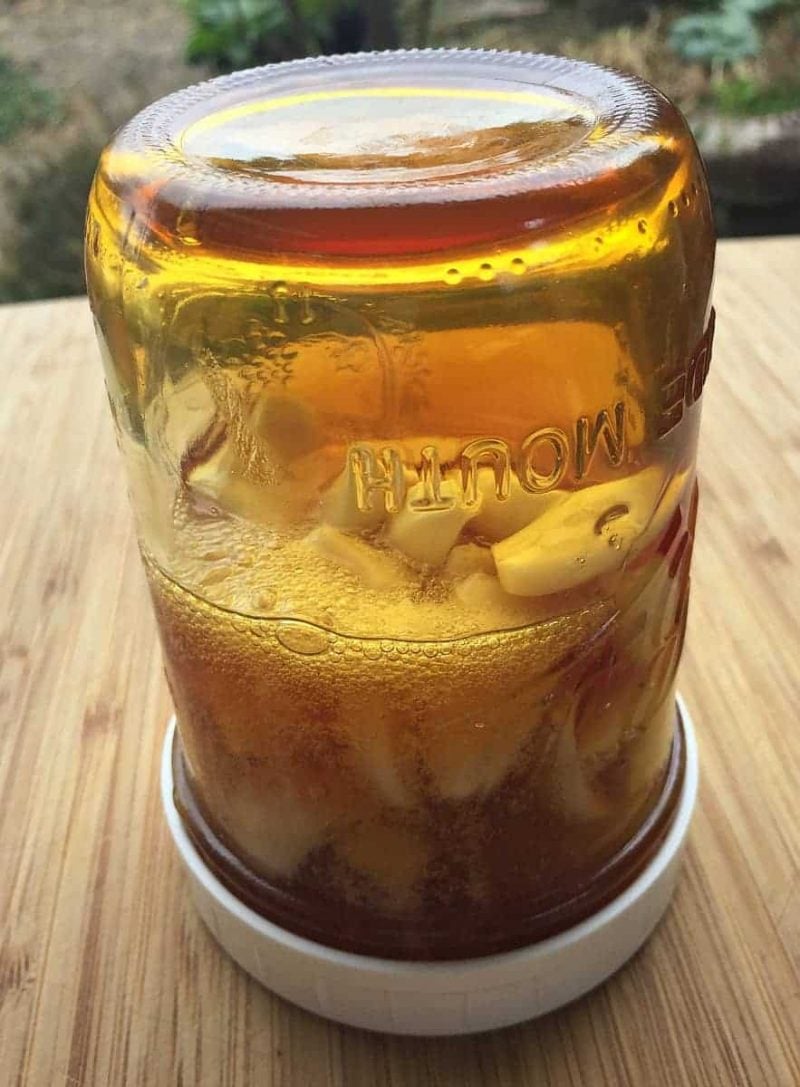
In a few days to a week you will notice some bubbles forming on the surface of the honey. Hooray!
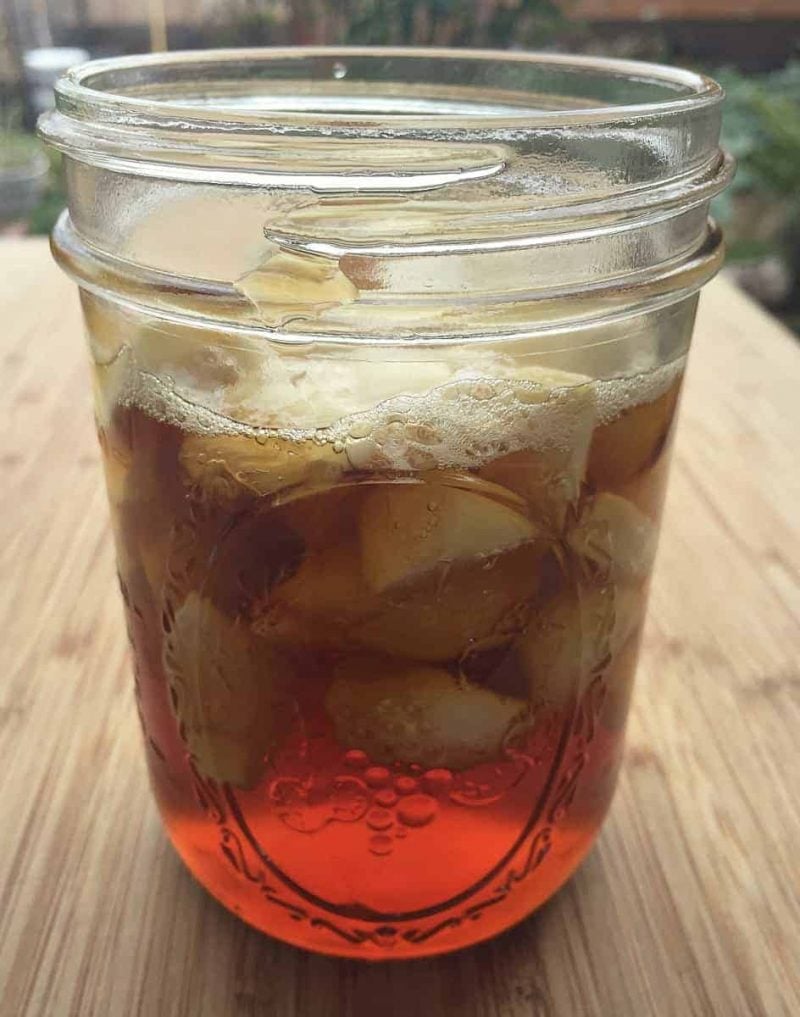
The honey garlic will ferment for about a month, but you can eat it at any time during the process.
The flavor will continue to develop over time, the garlic will mellow, and the honey will become much runnier.
Occasionally the garlic cloves turn a blue or green color due to a reaction during the fermentation process. While it may be a bit alarming, it is not harmful and the honey garlic can still be used.
Honey garlic will store well in a cool place for many months, or even a year or longer! I’ve kept some for over two years and it is still good.
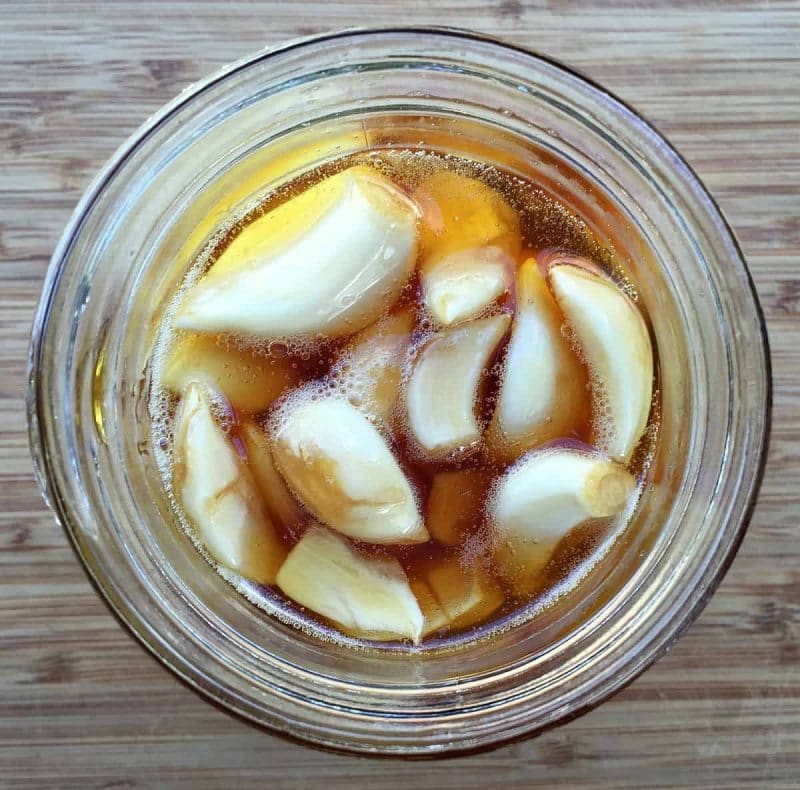
Using Fermented Honey Garlic
Now, how do you use this fermented honey garlic? That’s a good question, and it can be used in a variety of ways.
Both garlic and honey have strong medicinal properties, so it makes sense to use it as an immune booster or if you feel a cold or flu coming on.
Pop a whole garlic clove, or take a spoonful of honey (or both!).
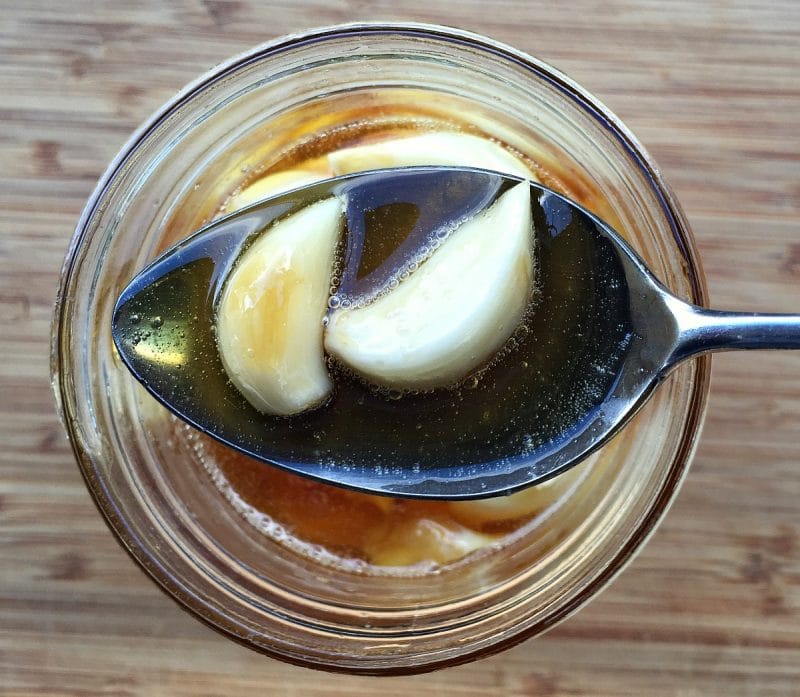
As you can probably imagine, honey garlic also makes a wonderful food!
It’s a natural in marinades and sauces, and would make a really tasty glaze for meats or veggies. Basically anything where you would normally use honey and garlic together!
Is Botulism a Concern in Honey Garlic?
I get this question a lot about fermented honey garlic! The short answer is no, botulism is really not a concern in this type of ferment.
While botulism can happen in garlic and oil preparations without added acidity, the fermentation process that happens here makes it very unlikely.
Raw honey is acidic, and while it can carry botulism spores (which is why it is not recommended for babies under 1 year), the level of acidity stops them from reproducing, which is what causes botulism.
If you are concerned about it, use a pH test strip. Botulism spores can’t reproduce with a pH of less than 4.6. Honey is usually around 3.9, but that can vary between brands.
If the pH is too high, add a splash of raw apple cider vinegar to add more acidity and retest. This is generally not needed, but I did want to mention it.
Honey garlic should not be given to babies under one year of age.
I really hope you make this yummy honeyed garlic! It’s super easy, and great to have on hand. I have a feeling it’s going to become a staple in our house!
Have you ever made fermented honey garlic? How do you use it?
More Fermented and Infused Honey Recipes
Enjoy these other recipes that showcase fermented and infused honey!
- Fermented Honey Cranberries
- Fermented Elderberry Honey
- Herbal Infused Honey
- Lilac Flower Infused Honey
Fermented Honey Garlic
Equipment
Ingredients
- 1 cup whole garlic cloves peeled and slightly crushed
- 1 cup raw honey or more, as needed to cover garlic
Instructions
- Place the peeled garlic cloves into a wide-mouth pint sized mason jar. Add enough honey to completely cover the garlic cloves. Make sure they are coated with honey.
- Place the lid on the jar loosely, then tuck into a dark place.
- Every day or so, tighten the lid on the jar and flip it upside down to coat the garlic cloves with honey. Loosen the lid again when you return it to the upright position.
- Within a few days to a week, you should see small bubbles start to form on the surface of the honey.
- The honey garlic will ferment for about a month, but you can eat it at any time. The flavor will continue to develop over time, the garlic will mellow, and the honey will become much runnier.
- Store in a cool place for many months or even a year, if not longer.
Notes
- It’s important to use raw honey for this recipe, as it has all of the bacteria and wild yeast that is necessary for fermentation.
- The small amount of juice from the garlic will create just enough liquid for fermentation to happen.
- It’s a good idea to put a plate underneath the jar during fermentation, as it will likely bubble up and a little bit of honey could possibly drip out.
- Occasionally the garlic cloves turn a bluish or greenish color during the fermentation process. While it may be a bit alarming, it is not harmful and the honey garlic can still be used.
- If you are concerned about botulism, use a pH test strip. Botulism spores can't reproduce with a pH of less than 4.6. Honey is usually around 3.9, but that can vary between brands.
- If the pH is too high, add a splash of raw apple cider vinegar to add more acidity and retest. This is generally not needed, but I do want to mention it.
- Honey garlic should not be given to babies under one year of age.

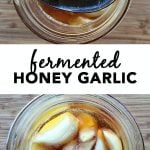
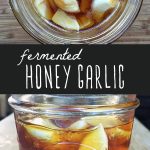
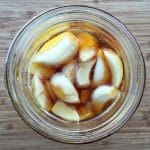

I have followed this recipe, including flipping the jar etc. 2 weeks on I’ve seen very little bubbles, now gone. The cloves are starting shrivel up, which happened last time I tried to make fermented garlic honey. Last time the cloves were not very edible after shrinking/shrivelling and the honey didn’t taste much better. I used raw honey and locally grown garlic. What could I be doing wrong?
Is your garlic very dry? I’ve never seen garlic cloves shrivel up during the fermented honey process. It could be that your garlic isn’t leaching enough moisture into the honey to cause fermentation to start. Are you fermenting your honey in a warm environment? 70°F and 80°F is ideal. Beyond that, I don’t see any reason why there isn’t any fermentation.
Thanks for replying. The cloves were fairly fresh, definitely not dry (only the skin).
Temperature is fairly warm, within that range. I didn’t cut or smash the cloves. Do you think it would help if I cut them up a bit?
Hi Sarah. You could definitely try cutting or smashing them. I’m sorry, I don’t know what else could be preventing them from fermenting.
Hello,
I made a jar of honey and garlic and i have kept it for more than 5 months now. I tried eating some earlier and everything just tasted sweet. I could not taste the garlic at all now. Can I still consume it? Or is it time for me to make new batches?
If you don’t like the flavor, of course you can make a new batch!
I was just trying to flavor my honey with a little garlic and googled it and stumbled upon your recipe. I put my garlic minced in organic Raw unfiltered honey from Costco. Should I have not minced the garlic? Do you think I would be okay just letting this sit for a day or two for flavor and then start over without minced garlic?
Hi Heather. Mincing the garlic works great. It should flavor your honey just fine, but typically you want to let it sit for at least a month to ferment.
Hello, thank you for sharing your recipe. I made 4 small jars. One jar the garlic is completely covered, the other three, the garlic is exposed slightly at the top. I have been flipping them over every couple days. Do I need to add more honey or will they be fine?
Also, at some point can I put them into the fridge and no longer need to burp them?
Thank you!
Hi Catherine. No, you shouldn’t add more honey, as this will increase your risk of contamination. Fermented honey garlic is shelf stable, it should not be refrigerated. Once the bubbles stop coming to the surface, (usually about a month) you can screw the lid down and store it in your kitchen pantry or cabinet.
Can this recipe be combined with jalapeños?
Sure!
Thank you <3
Hi there! I’ve set this recipe up ~2 weeks ago. The problem is I’m not noticing any bubbles at the top of my mixture! Also, when burping, the mixture smells extremely potent! Just want to check your perspective. For some additional context, my jar doesn’t seal perfectly, it definitely lets out some air.
Your fermented honey garlic is likely fine! Bubbles may be subtle since honey ferments slowly, especially in cooler temps. The strong smell when burping is normal due to garlic’s sulfur compounds and is completely normal. Since your jar isn’t fully sealed, CO₂ may be escaping gradually, which could be why you’re not seeing bubbles. If there’s no mold and the garlic is submerged, just stir or flip the jar daily and keep it in a slightly warmer spot to encourage fermentation.
Hi Coleen. I’m very happy to have discovered your blog! I grow garlic and lots of other veggies. I’m also fortunate to host honeybees in our garden every summer. I’m totally hooked on honey ferments and have made several. (Vanilla/ginger and cranberry are both nice). A few months ago I made a garlic and jalapeño fermented honey. So delicious on pizza!
Hi Sheila! Yum! I love the idea of fermenting vanilla and ginger together!
I just made a second batch (first one was last year). I had three thin slivers of organic raw ginger to the organic garlic cloves and raw honey. Is this okay or would the ginger hinder fermentation?
Nope, that’s totally fine. I have a recipe for fermented honey ginger on my site too, ginger ferments very well.
Hi! I love this recipe and have made several batches already. My most recent is the first that has a few blue/green garlic cloves within the first two weeks of fermentation. I know you mentioned it is safe to eat. Do you know what causes the change in color? I get concerned about bacteria and mold and would love your insight.
the blue/garlic color you’re seeing is caused by a chemical reaction between the sulfur compounds in the garlic and amino acids. It’s completely safe and harmless.
Can I use frozen shrimp instead of the garlic?
Frozen shrimp?? No, I don’t recommend using shrimp, frozen or otherwise.
I have pre-peeled garlic that is in a brine. Should I include the brine with the honey or take the brine out and just use the garlic with the honey? I am new to this and not sure what to do
I would only use the garlic, no brine.
Can I use sauerkraut weights instead of flipping it daily?
Sure!
I peal cloves and then shrink wrap – then into freezer for later use. works great
question is , will it ferment in honey afer being frozen ?
Hi Carl. I think frozen cloves should work!
Diagnosed with bacterial pneumonia & now have damaged kidneys living in hope that the cleansing properties will help me.
So glad I found your page. Thank you.
Does it matter what type of lid you use? Do you have to use the metal mason jar lid or can you use a plastic one?
No, it doesn’t matter.
Hello – should I rinse the garlic after peeling?
No.
I did mine last night and stuck in the fridge, I noticed in the comments you said no fridge. Is it too late to take out?
You should take it out. It’ll be fine.
Thanks for the useful blog. I use honey and garlic separately. Is it effective like your Fermented Honey Garlic?
Both honey and garlic are medicinal in their own right, but fermentation creates beneficial bacteria that provide immune boosting properties, and aid in digestion.
Where do you store jt once fermented? The counter or fridge?
In a dark kitchen cabinet.
Hello!
Do you need to loosen the lid, flip the jar and tighten it again throughout the whole time you have the jar?
Thanks!
No, only until it finishes fermenting, about a month. You’ll know when it’s done because no bubbles will come to the surface.
After that first month when the fermenting process is done, is it ok to keep in the fridge for a cool place or would you recommend to still keep in a dark cabinet at room temperature?
Dark cabinet at room temperature. Honey should never be refrigerated.
How much and how offten do you eat?
You can eat however much or whenever you want!
My garlic keeps floating to the top of the honey, is this okay?
Yes, that’s the reason why you’re flipping it every day.
How do you tell if it is still good? Have a little left over from last year and was hoping to add a new batch to it.
As long as it smells good and there isn’t any mold, it should be fine. I will sometimes add a splash of ACV to reduce the pH.
I have several questions.
Do you eat the garlic or just the honey?
If you just eat the honey, do you just add more honey and reuse the same garlic over and over?
Since fermenting takes up to 30 days and can last for a year, I’m thinking about starting 2 jars at once so that when I’ve used up one jar, another is sitting and waiting, while I restart the 1st jar. Does that make sense? Any suggestions?
I eat both the honey and garlic, together or separate. It’s not recommended to add more honey to the same jar because that will increase the risk of cross-contamination. Your plan for creating too jars is a good one! Enjoy!
Is this recommended while breastfeeding?
Yes, that’s fine!
Is it normal for the garlic cloves to float to the top of the honey & not be submerged in the honey? I pressed them down but they keep floating up.
Yes, that’s why the jar needs to be flipped every day. It’s to keep them coated in honey.
What if the honey criticized?
You will need to put the jar of honey in pot of warm, but not hot water until the honey turns liquid again.
Can you ferment if it’s in fridge? We tend to have ant issues here. Ty
No. It will not ferment in the fridge.
Our cellar is cool and dark, but I’m wondering if it’s too cool for fermentation to take place. It’s 56 degrees Fahrenheit. Thanks!
Yes, that’s too cold. You’ll want to keep it above 60 degrees, ideally around 68 degrees.
Hi! Is it safe to use daily? My son (5 yo) has asthma and allergies and I notice this helps him. I give him a spoonful almost every night…
Yes, that’s fine!